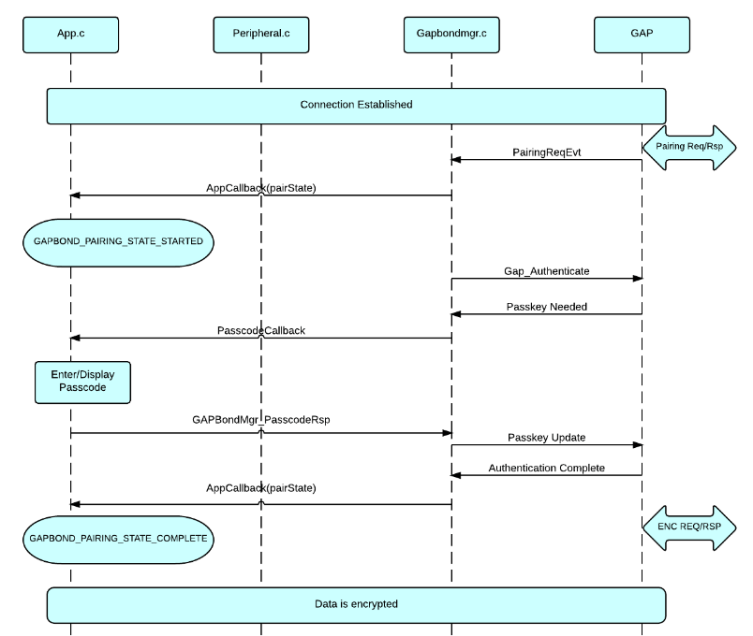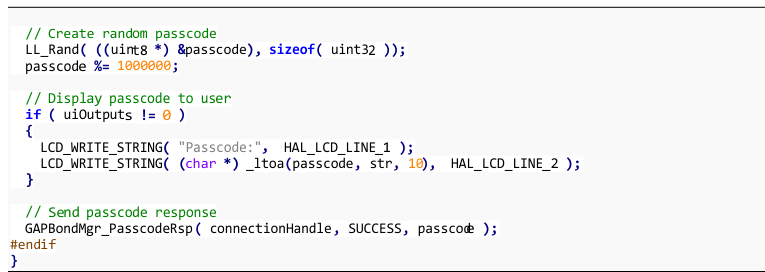SWRU271I October 2010 – January 2020 CC2540 , CC2540T , CC2541 , CC2541-Q1 , CC2640R2F
- Preface
- 1Overview
- 2The TI Bluetooth Low Energy Software Development Platform
- 3The Operating System Abstraction Layer (OSAL)
- 4The Application and Profiles
-
5The Bluetooth Low Energy Protocol Stack
- 5.1 Overview
- 5.2 Generic Access Profile (GAP)
- 5.3 GAPRole Task
- 5.4 Gap Bond Manager (GAPBondMgr)
- 5.5
Generic Attribute Profile (GATT)
- 5.5.1 GATT Characteristics and Attributes
- 5.5.2 GATT Services and Profile
- 5.5.3 GATT Client Abstraction
- 5.5.4 GATT Server Abstraction
- 5.6 L2CAP
- 5.7 HCI
- 5.8 Library Files
- 6Drivers
- 7Creating a Custom Bluetooth Low Energy Application
- 8Development and Debugging
-
9General Information
- 9.1 Overview
- 9.2 Porting From BLE-Stack 1.5.0 to 1.5.1
- 9.3 Porting From BLE-Stack 1.4.2 to 1.5.0
- 9.4
Porting From Earlier BLE-Stack Versions
- 9.4.1 Porting BLEv1.4.1 Projects to BLEv1.4.2
- 9.4.2 Porting BLEv1.4.0 Projects to BLEv1.4.1
- 9.4.3 Porting BLEv1.3.2 Projects to BLEv1.4.0
- 9.4.4 Porting BLEv1.2 Projects to BLEv1.3
- 9.4.5 Porting From CC2540 to CC2541 Project
- 9.5 Release Notes History
- 9.6 Document History
- A GAP API
- B GAPRole Peripheral Role API
- C GAPRole Central Role API
- D GATT/ATT API
- E GATTServApp API
- F GAPBondMgr API
- G HCI Extension API
- Revision History
5.4.3.4 Authenticated Pairing
Authenticated pairing requires MITM protection. This method is a way of transferring a passcode between the devices. The passcode cannot transmit wirelessly and is displayed on one device (typically on an LCD screen or a serial number on the device) and entered on the other device.
To pair with MITM authentication, use the following settings:


This method requires an additional step in the security process in Figure 5-7. After pairing is started, the GAPBondMgr notifies the application that a passcode is required through a passcode callback. Depending on the input and output capabilities of the device, the device must display and/or enter the passcode. If entering a passcode, the application sends this passcode to the GAPBondMgr.
 Figure 5-7 Pairing With MITM Authentication
Figure 5-7 Pairing With MITM Authentication This passcode communication with the GAPBondMgr uses a passcode callback function when registering with GAPBondMgr. You must add a passcode function to the GAPBondMgr application callbacks. The following is an example of a passcode function.

When the GAPBondMgr requires a passcode, the GAPBondMgr use the following callback to request a passcode from the application. Depending on the input and output capabilities of the devices, the callback function should either display a passcode or read in an entered passcode. This passcode must be sent by the application to the GAPBondMgr using the GAPBondMgr_PasscodeRsp() function. The following is an example of the SimpleBLECentral.


In the previous example, a random password is generated and displayed on an LCD screen by the passcode callback function. The other connected device must then enter this passcode.